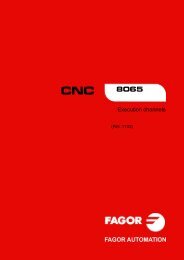CNC 8037 T - Manual de programación - Fagor Automation
CNC 8037 T - Manual de programación - Fagor Automation
CNC 8037 T - Manual de programación - Fagor Automation
Create successful ePaper yourself
Turn your PDF publications into a flip-book with our unique Google optimized e-Paper software.
11.<br />
PROGRAMACIÓN EN LENGUAJE DE ALTO NIVEL<br />
Variables<br />
<strong>CNC</strong> <strong>8037</strong><br />
MODELO ·T·<br />
SOFT: V01.4X<br />
·208·<br />
11.2.7 Variables asociadas a las cotas<br />
Los valores <strong>de</strong> las cotas <strong>de</strong> cada eje se expresan en las unida<strong>de</strong>s activas:<br />
Si G70, en pulgadas (entre ±3937.00787).<br />
Si G71, en milímetros (entre ±99999.9999).<br />
Si eje rotativo en grados (entre ±99999.9999).<br />
Variables <strong>de</strong> lectura<br />
<strong>Manual</strong> <strong>de</strong> <strong>programación</strong><br />
Si se acce<strong>de</strong> a alguna <strong>de</strong> las variables POS(X-C), TPOS(X-C), APOS(X-C), ATPOS(X-C) o<br />
FLWE(X-C) se <strong>de</strong>tiene la preparación <strong>de</strong> bloques y se espera a que dicho comando se ejecute para<br />
comenzar nuevamente la preparación <strong>de</strong> bloques.<br />
Las cotas que proporcionan las variables PPOS(X-C), POS(X-C), TPOS(X-C), APOS(X-C) y<br />
ATPOS(X-C), estarán expresadas según el sistema <strong>de</strong> unida<strong>de</strong>s (radios o diámetros) activo. Para<br />
conocer el sistema <strong>de</strong> unida<strong>de</strong>s activo, consultar la variable DIAM.<br />
PPOS(X-C)<br />
Devuelve la cota teórica programada <strong>de</strong>l eje seleccionado.<br />
POS(X-C)<br />
Devuelve la cota real <strong>de</strong> la base <strong>de</strong> la herramienta, referida al cero máquina, <strong>de</strong>l eje seleccionado.<br />
En los ejes rotativos sin límites esta variable tiene en cuenta el valor <strong>de</strong>l traslado activo. Los valores<br />
<strong>de</strong> la variable están comprendidos entre el traslado activo y ±360º (ORG* ± 360º).<br />
Si ORG* = 20º visualiza entre 20º y 380º / visualiza entre -340º y 20º.<br />
Si ORG* = -60º visualiza entre -60º y 300º / visualiza entre -420º y -60º.<br />
TPOS(X-C)<br />
Devuelve la cota teórica (cota real + error <strong>de</strong> seguimiento) <strong>de</strong> la base <strong>de</strong> la herramienta, referida<br />
al cero máquina, <strong>de</strong>l eje seleccionado.<br />
En los ejes rotativos sin límites esta variable tiene en cuenta el valor <strong>de</strong>l traslado activo. Los valores<br />
<strong>de</strong> la variable están comprendidos entre el traslado activo y ±360º (ORG* ± 360º).<br />
Si ORG* = 20º visualiza entre 20º y 380º / visualiza entre -340º y 20º.<br />
Si ORG* = -60º visualiza entre -60º y 300º / visualiza entre -420º y -60º.<br />
APOS(X-C)<br />
Devuelve la cota real <strong>de</strong> la base <strong>de</strong> la herramienta, referida al cero pieza, <strong>de</strong>l eje seleccionado.<br />
ATPOS(X-C)<br />
Devuelve la cota teórica (cota real + error <strong>de</strong> seguimiento) <strong>de</strong> la base <strong>de</strong> la herramienta, referida<br />
al cero pieza, <strong>de</strong>l eje seleccionado.<br />
FLWE(X-C)<br />
Devuelve el error <strong>de</strong> seguimiento <strong>de</strong>l eje seleccionado.<br />
DPLY(X-C)<br />
Devuelve la cota representada en pantalla para el eje seleccionado.<br />
GPOS(X-C)n p<br />
(P110=PPOSX)<br />
Asigna al parámetro P100 la cota teórica programada <strong>de</strong>l eje X.<br />
Cota programada para un <strong>de</strong>terminado eje, en el bloque (n) <strong>de</strong>l programa (p) indicado.

















